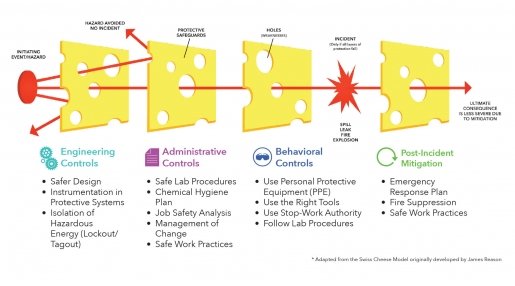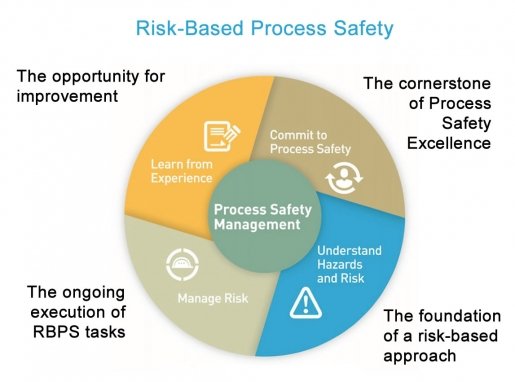Expect the unexpected. Assess your risks. Prevent incidents.
What is Process Safety?
Process safety is about understanding hazards and risk, managing risk by providing the appropriate layers of protection to reduce the frequency and severity of incidents, and learning from incidents when they happen.
It involves:
- Identification and understanding of potential hazards
- Evaluation of consequences, safeguards, and risks
- The addition of layers of protection (safeguards) to prevent and/or mitigate incidents
- The introduction of safeguards to protect the students, the staff, the faculty, the public, the environment, and property
Michigan Tech is committed to preventing the injuries, fatalities, and damage that can potentially result from human error in hazardous environments, including but not limited to research labs. The following have been introduced through the Department of Chemical Engineering and other units in support of process safety:
- A dedicated course, CM 4310 Chemical Process Safety/Environment
- The undergraduate student-owned lab safety program Prevent Accident with Safety (PAWS)
- Outreach initiatives intended to introduce process safety into the DNA of the Michigan Tech campus culture, by promoting a sense of vulnerability about incidents and by promoting understanding of hazards and risks
- Research in the following areas: process safety management systems, inherently safer design, process hazard analysis, quantitative risk analysis, fire suppression materials and characterization, membrane integrity, and thermal run-away in energy storage devices
The Swiss Cheese Model
The Swiss cheese model of process safety illustrates, through layers in a block of Swiss cheese, the processes that can prevent safety incidents. The concept is adapted from the original Swiss cheese model by James Reason.
The layers are represented as protective safeguards (cheese) and weaknesses (holes). When an initiating event—one that might lead to a hazard—encounters a safeguard at any layer, the hazard is avoided and no incident occurs. When it passes through holes in all the layers, representing failures of all safeguards, then an incident occurs. The incident might represent a spill, leak, fire, or explosion. If an incident occurs, then mitigation reduces the severity of consequences.
Here are some common safeguards that represent the Swiss cheese layers. They are ordered sequentially from the initiating event to the ultimate consequence:
Engineering Controls > Administrative Controls > Behavioral Controls > Post-Incident Mitigation
Engineering Controls
- Safer design
- Instrumentation in protective systems
- Isolation of hazardous energy (lockout/tagout)
Administrative Controls
- Safe lab procedures
- Chemical hygiene plan
- Job safety analysis
- Management of change
- Safe work practices
Behavioral Controls
- Use personal protective equipment (PPE)
- Use the right tools
- Use stop-work authority
- Follow lab procedures
Post-Incident Mitigation
- Emergency response plan
- Fire suppression
- Safe work practices
Learn more about the Swiss cheese model in cultivating a safety-oriented mindset within the academic community.
Risk-Based Process Safety
The risk-based process safety (RBPS) management approach is based on four pillars and 20 elements.
Commit to Process Safety
This is the cornerstone of process safety excellence.
- Process safety
- Compliance with standards
- Process safety competency
- Workforce involvement
- Stakeholder outreach
Understand Hazards and Risk
This pillar represents the foundation of a risk-based approach.
- Process knowledge management
- Hazard identification and risk analysis
Manage Risk
This involves the ongoing execution of RBPS tasks.
- Operating procedures
- Safe workplaces
- Asset integrity and reliability
- Contractor management
- Training and performance assurance
- Management of change
- Operational readiness
- Conduct of operations
- Emergency management
Learn from Experience
This provides opportunities for improvement.
- Incident investigation
- Measurement and metrics
- Auditing
- Management review and continuous improvement
What’s Your Role?
Questions to Ask Yourself
- What can go wrong?
- How bad can it be?
- How often might it happen?
- Are the proper safeguards in place?
- How can I better manage this risk?
Behaviors to Practice
- Use PPE
- Use the right tools
- Use stop-work authority
- Follow lab procedures
Avoid the Consequences
- Personal injury
- Loss of life
- Contamination of air, water, or soil
- Loss of property
Report Concerns
- Contact instructor or lab supervisor
- Contact department chair
- Contact EHS: email ehs@mtu.edu or call 906-487-2118
Process safety is a team effort!

